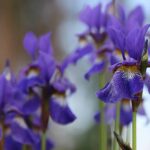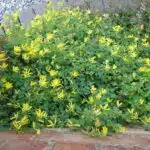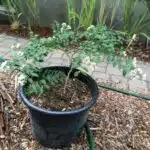Yellow Flag Iris, also known as Iris pseudacorus, is a perennial plant that belongs to the Iridaceae family. This plant is well-known for its striking yellow flowers that bloom in late spring and early summer. Yellow Flag Iris can grow up to 1-2 meters tall and requires minimal care once established. In this article, we will discuss how to grow and care for Yellow Flag Iris, including planting techniques, soil requirements, watering regimen, and pest management.
Growing Yellow Flag Iris requires adequate sunlight exposure and well-drained soil. It is best to plant them during the fall season or early spring when the soil is still moist. The ideal location for Yellow Flag Iris should have at least six hours of direct sunlight per day. In terms of soil requirements, it should be rich in organic matter and have a pH level between 5.5-7.0. Additionally, it is recommended to add compost or aged manure to the soil before planting to provide additional nutrients necessary for growth. Proper watering techniques are crucial for the success of Yellow Flag Iris growth as they require regular watering but also need well-draining soil to prevent waterlogging. By following these tips, any gardener can successfully grow and care for their own beautiful Yellow Flag Iris plants at home or in their garden area.
Planting Yellow Flag Iris In Your Garden
Yellow flag iris, also known as Iris pseudacorus, is a stunning plant that can add a touch of elegance to any garden. Symbolically, it represents hope and faith. It is an extremely versatile plant and can be grown in a variety of settings such as in water gardens or boggy areas. Before planting yellow flag iris, it’s important to consider its companion plants. This species works well with cattails, rushes, and sedges.
Container gardening is also an option for those who don’t have enough space in their garden or want to grow this plant indoors. Yellow flag iris thrives in soil that is rich in organic matter and needs to be planted at a depth of around six inches. When planting multiple bulbs, make sure that they are spaced around 12 inches apart from each other.
To ensure the health and longevity of your yellow flag iris, it’s essential to choose the right location for planting. In the next section, we will discuss how to select the perfect spot for growing this beautiful plant.
Choosing The Right Location For Your Iris
To ensure the healthy growth of your yellow flag iris, it is crucial to select the right location. This plant thrives in moist soil and requires sun exposure for at least six hours daily. Choose a spot that provides these conditions and has good drainage. The best soil for yellow flag iris cultivation is one that is rich in organic matter, with a pH level of 6.0 to 7.5.
If you are planting your yellow flag iris near a body of water, ensure that the area does not flood frequently as this may damage the plant’s roots. Additionally, avoid areas that are prone to strong winds as this can cause damage to the foliage and flowers. Planting your yellow flag iris in an area with minimal competition from other plants will also help it thrive.
In summary, choosing the right location for your yellow flag iris will determine its growth and overall health. Look for an area with well-draining soil, adequate moisture, and at least six hours of sunlight per day. Avoid areas with strong winds or flooding tendencies and plant where there is minimal competition from other plants. In preparing the soil for planting, there are essential steps to follow to ensure optimal growth of your yellow flag iris.
Preparing The Soil For Planting
So, you want to grow yellow flag iris? Well, if you’re anything like me, then you’re probably eager to jump right in and start planting. However, before we get ahead of ourselves, it’s important to ensure that our soil is properly prepared. Testing soil is an essential step that can’t be overlooked as it determines whether your plant will thrive or wither.
The first step in preparing your soil is to test its pH levels. Yellow flag iris prefer a slightly acidic soil between 5.5 and 6.5 pH. You can use a pH testing kit found at any gardening store to determine the acidity of your soil. Once you’ve determined the pH level, you can adjust it using lime or sulfur to ensure it falls within the preferred range.
Once your pH levels are ideal, it’s time to consider the availability of nutrients in your soil. A nutrient-rich soil will provide your yellow flag iris with everything they need to thrive and produce beautiful blooms year after year. You can determine which nutrients are lacking in your soil by conducting a soil test through a local extension office or online retailer. Based on the results from this test, you can add organic matter such as compost or manure to enrich the soil with essential nutrients.
Now that we’ve covered testing soil and ensuring proper nutrients are available, it’s time to move on to when to plant yellow flag iris. With healthy and fertile soil prepared, you’re ready for the next step towards growing beautiful yellow flag iris plants!
When To Plant Yellow Flag Iris
After preparing the soil for planting, it’s important to know when to plant yellow flag iris. The best time to plant this hardy perennial is in early spring or late summer when temperatures are mild and rainfall is abundant. This ensures that the newly planted rhizomes have enough moisture to establish themselves before the heat of summer or the cold of winter sets in.
Yellow flag iris is a versatile plant that can grow in a range of climate conditions. However, it thrives best in areas with moist soil and full sun exposure. It can also tolerate partial shade, but too much shade will reduce its growth potential and flower production. In terms of temperature, yellow flag iris can withstand both hot summers and cold winters, making it an ideal choice for gardens located in regions with variable weather patterns.
When it comes to planting yellow flag iris, there are a few key steps to follow. First, select a well-draining site with plenty of sunlight or partial shade. Next, dig a hole that is large enough to accommodate the rhizome without bending or breaking it. Place the rhizome in the hole and cover it with soil until only the top portion is visible above ground level. Water thoroughly and mulch around the base of the plant to retain moisture and suppress weed growth.
Transition: Now that you know when the best time is to plant yellow flag iris and its climate requirements, let’s move on to how you can properly plant this beautiful perennial in your garden.
How To Plant Yellow Flag Iris
To plant yellow flag iris, choose a location that is consistently moist and receives full sun to partial shade. These plants prefer wet soil, so consider planting them near the edge of a pond or stream. Prepare the planting area by removing any weeds, rocks, or debris and loosening the soil to a depth of about 6 inches.
Once the planting area is prepared, dig a hole that is deep enough to accommodate the roots of your yellow flag iris. Place the plant in the hole and backfill with soil, tamping down gently to remove any air pockets. Water thoroughly after planting and continue to keep the soil consistently moist.
Common mistakes when planting yellow flag iris include placing them in soil that is too dry or not providing enough sunlight. Optimal conditions for these plants include a consistently moist environment with at least 6 hours of sun per day. By following these guidelines, you can ensure healthy growth and vibrant blooms from your yellow flag iris.
- For best results, incorporate organic matter such as compost or peat moss into the soil before planting.
- Consider adding a layer of mulch around your yellow flag iris to help retain moisture in the soil.
- Avoid overcrowding by spacing plants at least 18 inches apart.
Moving forward, proper watering techniques are crucial for maintaining healthy yellow flag iris plants. By providing consistent moisture without overwatering, you can help prevent root rot and promote strong growth. In the next section, we will explore how to water your yellow flag iris effectively.
Watering Your Yellow Flag Iris
After successfully planting your yellow flag iris, it is crucial to provide it with adequate water to promote healthy growth. One effective way to do this is through drip irrigation. By using this method, you can ensure that water is delivered directly to the roots of the plant in a slow and steady manner. This not only conserves water but also prevents overwatering which can cause root rot.
To establish a watering schedule for your yellow flag iris, consider the weather conditions in your area. During hot and dry periods, you may need to increase the frequency of watering. Conversely, during cooler and wetter seasons, you can reduce the frequency of watering. Additionally, monitor the moisture level of the soil by inserting your finger into the ground near the plant’s base. If it feels dry at a depth of 1-2 inches, it’s time to water.
In summary, providing consistent moisture is key when caring for yellow flag iris plants. Using drip irrigation and establishing a regular watering schedule will help ensure that your plant receives adequate hydration without becoming waterlogged or dehydrated. With proper care, your yellow flag iris will thrive and produce beautiful blooms season after season.
As we have discussed how to properly water your yellow flag iris in this section, next we will explore another important aspect of caring for this stunning plant: fertilization.
Fertilizing Your Yellow Flag Iris
When it comes to fertilizing yellow flag iris, timing is key. Fertilizing should generally be done at the beginning of spring, as this is when the plant will begin to actively grow. The best types of fertilizer to use on a yellow flag iris are slow-release, balanced fertilizers. These fertilizers should be applied at a rate of 2 to 3 pounds per 100 square feet. Fertilizing frequency should be based on soil fertility and the condition of the plants, and should generally be done every 4 to 6 weeks. Additionally, yellow flag iris should be watered thoroughly after each fertilizer application.
When To Fertilize
To keep your yellow flag iris healthy and blooming, it’s important to fertilize them at the right time. The best time to fertilize is in early spring when the plants are just starting to grow. This will give them a nutrient boost as they enter their growing season. Fertilizing later in the summer can lead to excessive foliage growth and fewer blooms.
When choosing a fertilizer for your yellow flag iris, look for one that is high in nitrogen. This will promote healthy leaf growth and strong stems. However, be sure to measure your soil’s pH before applying any fertilizer. Yellow flag irises prefer slightly acidic soil with a pH between 6.0 and 7.5. If your soil is too alkaline, the plant may not be able to absorb nutrients properly.
To determine how much fertilizer to use, follow the instructions on the package carefully. In general, you’ll want to apply about 1 pound of fertilizer per 100 square feet of planting area. Spread the fertilizer evenly over the soil surface and then water well to help it dissolve into the soil. With proper fertilization, your yellow flag iris should thrive and produce beautiful blooms year after year!
Types Of Fertilizer
When it comes to fertilizing yellow flag irises, choosing the right type of fertilizer is just as important as timing and quantity. As a gardening expert or horticulturalist, you should be familiar with the different types of fertilizers available in the market. Organic and synthetic fertilizers are two common categories that you can choose from.
Organic fertilizers are made from natural materials such as animal manure, compost, and bone meal. They release nutrients slowly and steadily over time, which makes them ideal for long-term plant growth. On the other hand, synthetic fertilizers are manufactured using chemical compounds that provide an instant nutrient boost to plants. They come in both slow-release and liquid forms, with slow-release being a more popular option.
If you prefer organic options for your yellow flag iris, then you can use compost or well-rotted manure that is high in nitrogen content. These types of fertilizers enhance soil structure and improve water retention capabilities while also providing essential nutrients to your plants. However, if you need quick results or have specific nutrient deficiencies in your soil, then synthetic fertilizers may be a better option for you.
In conclusion, understanding the differences between organic and synthetic fertilizers can help you make an informed decision about what type of fertilizer to use on your yellow flag iris. Both types have their own advantages and disadvantages depending on your specific needs as a gardener. Ultimately, it’s up to you to decide what works best for your garden and take proper care of your beloved plants!
Fertilizing Frequency
Fertilizing frequency is another important aspect of taking care of your yellow flag iris. When deciding how often to fertilize, it’s essential to consider the type of fertilizer you’re using – organic or synthetic. Organic fertilizers release nutrients slowly over time and generally require less frequent application. On the other hand, synthetic fertilizers provide an instant nutrient boost and may need to be applied more frequently.
If you choose to use organic fertilizers on your yellow flag iris, you can typically fertilize once or twice a year. It’s best to apply fertilizer in early spring before new growth appears and again in early summer if necessary. However, if you opt for synthetic fertilizers, you may need to fertilize more frequently – usually every four to six weeks during the growing season.
It’s essential to avoid over-fertilizing your yellow flag iris as this can cause damage and lead to stunted growth. Signs of over-fertilization include burnt or scorched leaves, wilting, and reduced flowering. Be sure to follow the instructions on the fertilizer package carefully and do not exceed recommended application rates. By understanding the differences between organic vs synthetic fertilizers and applying them at appropriate intervals, you can ensure healthy growth for your beloved yellow flag iris!
Mulching Your Iris Bed
Using organic mulch is an effective way to maintain the health and vigor of your yellow flag iris bed. Mulching provides several benefits that contribute to the growth and development of these plants. Firstly, it helps regulate soil temperature, keeping it cooler in hot weather and warmer during colder days. This helps protect the roots from extreme temperatures that can stunt their growth or even cause them to die.
Secondly, organic mulch prevents moisture loss by reducing evaporation from the soil surface. This retains the necessary moisture for healthy root development and encourages the growth of beneficial microorganisms that help break down organic matter into nutrients that are essential for plant growth.
Thirdly, organic mulch acts as a natural weed suppressant, which reduces competition for nutrients between weeds and your yellow flag iris. It also minimizes soil erosion, which is especially important if you have a sloping garden or live in an area with heavy rainfall.
In conclusion, using organic mulch is an excellent way to improve the health and appearance of your yellow flag iris bed. By regulating soil temperature, preventing moisture loss, suppressing weeds, and reducing soil erosion, you can promote healthy root development and encourage vigorous plant growth. In our subsequent section about managing pests and diseases, we will discuss how to identify common problems that may affect your yellow flag iris plants and how to treat them effectively.
Managing Pests And Diseases
Mulching your iris bed is an essential step to maintaining the health and beauty of your yellow flag iris. It helps retain moisture, suppress weeds, and regulate soil temperature. However, it’s not enough to ensure a pest and disease-free garden. As a responsible gardener, you must also take preventive measures to protect your plants from infestations and recognize common diseases that may affect them.
Preventing infestations is crucial in keeping your yellow flag iris healthy. One way to do this is by practicing good garden hygiene. Remove any dead or decaying plant material as they serve as breeding grounds for pests and diseases. Keep the area around your iris bed clean and weed-free. You can also use organic insecticides like neem oil or pyrethrin if necessary.
Recognizing common diseases that may affect your yellow flag iris is vital in managing their health effectively. One of the most common diseases is bacterial soft rot, which causes mushy spots on leaves, stems, and rhizomes. Leaf spot is another disease that causes brown spots on leaves, leading to defoliation if left untreated. Rust is also a frequent problem among irises, causing orange-yellow powdery spots on leaves.
Deadheading your yellow flag iris should be done regularly to encourage more blooms throughout the season. Deadheading involves removing spent flower stalks before they produce seeds. This process redirects the plant’s energy towards producing more flowers rather than seed production. Additionally, it prevents self-seeding, which can lead to overcrowding in your garden beds. Remember to sterilize your pruning shears before and after use to prevent the spread of diseases between plants.
Deadheading Your Yellow Flag Iris
Deadheading is an essential task that helps to promote the optimal growth and blooming of yellow flag iris. Deadheading involves removing spent flowers from the plant before they develop seeds. This process redirects the plant’s energy away from seed production towards root development, leading to more robust growth and better blooms. Deadheading also enhances the overall appearance of your garden, ensuring that your yellow flag iris looks neat and tidy.
One of the benefits of deadheading your yellow flag iris is that it promotes prolonged blooming. The removal of spent flowers triggers a response in the plant to produce new blooms, resulting in a longer flowering period. Regular deadheading encourages continued bloom throughout the growing season, providing you with a beautiful display of flowers for weeks on end.
Common mistakes while deadheading your yellow flag iris include cutting too far down on the stem or leaving untrimmed flower stalks. To avoid these mistakes, use sharp pruning shears or scissors to snip just below where the flower meets the stem. Avoid cutting too low on the stem as this may damage new buds and cause stunted growth. Additionally, ensure that you remove all old blooms as leaving even one can lead to seed formation and redirecting energy away from new flower development.
As essential as deadheading is for optimal growth and bloom, pruning is another vital aspect of maintaining your yellow flag iris’s health and beauty. Pruning involves removing any damaged or diseased leaves or stems from your plant, which not only improves its appearance but also reduces its susceptibility to pests and diseases. In the next section, we’ll discuss how to prune your yellow flag iris properly for optimal results.
Pruning Your Yellow Flag Iris
To ensure the vitality and health of your yellow flag iris, it is essential to perform pruning techniques periodically. Pruning helps in maintaining the shape and size of the plant, encourages better air circulation and reduces the risk of disease. Pruning also helps in removing dead or damaged foliage, which can help to prevent further damage to the plant.
Timing of pruning is critical when it comes to yellow flag iris. The best time to prune your plant is in late winter or early spring before new growth begins. It is crucial to wait until after the first frost has occurred as this will signal that the plant has entered a dormant phase. During this time, you can remove any dead leaves or stems that have not fallen off naturally.
To effectively prune your yellow flag iris, start by assessing its condition. Look for any signs of damage or dead foliage that needs removing. Use a sharp pair of scissors or pruning shears and make clean cuts at an angle just above a leaf node or bud. Be sure not to cut too close to the base of the plant as this can cause damage to living tissue.
Now that you are well-versed with pruning techniques for your yellow flag iris let’s move on to dividing your plant. By dividing your yellow flag iris, you can propagate new plants while also promoting healthier growth in existing ones. This process involves separating clumps into smaller sections and transplanting them into different areas where they can grow independently with proper care and attention.
Dividing Your Yellow Flag Iris
After pruning your yellow flag iris, it’s time to think about dividing it. Propagation techniques for this plant involve separating the rhizomes or underground stems in order to create new plants. Dividing your yellow flag iris is an important step to ensure the health and vitality of the plant.
The ideal season for dividing your yellow flag iris is in early spring or after blooming has finished. This allows enough time for the plant to properly establish itself before winter comes around. Before dividing, make sure to water the plant thoroughly a day or two prior to make it easier to separate the rhizomes.
When dividing, gently lift the clump out of the ground and shake off any excess soil. Use a sharp, clean knife or garden shears to cut apart the rhizomes and discard any dead or damaged sections. Replant each divided section at least 12 inches apart from each other and water well. With proper care and maintenance, you can enjoy a beautiful display of yellow flag iris blooms year after year.
Moving on from dividing your yellow flag iris, let’s now talk about overwintering this hardy plant.
Overwintering Your Yellow Flag Iris
- To successfully overwinter yellow flag iris, it is important for gardeners to prepare for the winter season in advance.
- During the winter season, it is important to water the yellow flag iris deeply and regularly, as well as to provide adequate mulch.
- Gardeners should also consider protecting their yellow flag iris from frost by covering the plants with a light blanket or frost cloth when temperatures drop below freezing.
- When temperatures begin to warm, it may be necessary for gardeners to remove the frost cloth or blanket to prevent the plants from overheating and drying out.
- During the winter season, gardeners should also consider pruning back the yellow flag iris to prevent the plants from becoming leggy and weak.
- Finally, gardeners should consider providing a slow-release fertilizer to the yellow flag iris in late winter to promote healthy growth and blooming.
Preparing For Winter
Protecting the foliage of your yellow flag iris during winter is crucial to ensure its survival and healthy growth in the following seasons. The first step in preparing your plants for winter is to cut back any dead or damaged foliage. This will help reduce the risk of disease and pests, as well as prevent any potential damage caused by heavy snowfall.
Once the foliage has been trimmed, it’s time to think about winter storage. Yellow flag iris prefer moist soil, so make sure to keep them in a cool, dark place where they won’t dry out. It’s important not to let the roots freeze, so consider storing them in a pot or container filled with peat moss or sawdust, which can help insulate them from extreme temperatures.
In addition to proper storage and cutting back of foliage, it’s also important to regularly check on your yellow flag iris during the winter months. Be on the lookout for signs of damage or disease, and take action immediately if necessary. With proper care and attention, your yellow flag iris will thrive come springtime.
Watering And Mulching
Overwintering your yellow flag iris is a crucial part of ensuring its survival and healthy growth in the following seasons. Aside from cutting back dead foliage and proper storage, watering and mulching are essential practices to help your plant thrive during the winter months.
Using drip irrigation is one of the best ways to water your yellow flag iris during winter. This method allows for slow and consistent watering, which helps prevent soil from completely drying out or becoming too saturated. Moreover, it also prevents waterlogging that can lead to root rot. Drip irrigation also conserves water by directing it straight to the plant’s roots instead of evaporating or run-off.
Choosing the right mulch is equally important as watering when it comes to overwintering your yellow flag iris. A good-quality mulch can help insulate your plants’ roots from extreme temperatures, retain moisture in the soil, suppress weeds, and add nutrients as they break down over time. Some recommended mulches include straw, shredded leaves, wood chips, or pine needles. However, avoid using fresh manure-based mulch that may contain weed seeds or harmful pathogens that can damage your plants.
Protecting From Frost
Ensuring the survival and growth of your yellow flag iris in the winter months is crucial, and proper overwintering practices are necessary. Aside from watering and mulching, covering your plants can provide additional protection from frost. Frost can damage or kill your plants by freezing the water inside their cells, causing them to burst and die.
One way to protect your yellow flag iris from frost is by using commercial plant covers or blankets made explicitly for this purpose. These covers can help trap heat around your plants, keeping them warmer during cold nights. However, if you don’t have access to these materials, you can also use other items such as blankets, tarps, or even old bed sheets. Just make sure that the cover reaches all the way down to the ground and doesn’t touch the plant’s leaves or flowers.
Another method of protecting your yellow flag iris from frost is by using water. Water has a high specific heat capacity, which means it takes longer to cool down than air or soil. By watering your plants before a frost event occurs, you can help raise their temperature slightly above freezing point. This will prevent ice formation inside their cells and reduce the risk of damage. However, be careful not to overwater as this can lead to root rot or other issues.
Propagating Your Yellow Flag Iris
One interesting statistic to consider when propagating your yellow flag iris is that each plant can produce up to 300 seeds per year. This means that with proper propagation techniques, you can easily expand your collection of these stunning flowers.
Propagation techniques for yellow flag iris include both seed propagation and division of the rhizomes. To propagate by seed, collect mature seed pods in the fall and plant them in a moist, well-draining soil mix. Keep the soil consistently moist until germination occurs. For division, dig up clumps of rhizomes in early spring or fall, cutting them into sections with at least one growing point each before replanting.
It’s important to note that yellow flag iris prefers moist soil with good drainage, so ensure that your planting location meets these soil requirements. With proper care and propagation techniques, you can enjoy the beauty of your yellow flag iris for years to come.
Enjoying The Beauty Of Your Yellow Flag Iris
After successfully propagating your yellow flag iris, it is now time to enjoy the beauty that it brings to your garden. This plant’s stunning yellow blooms can create a striking contrast against green foliage, making it an excellent addition to any landscape design.
Creating beautiful floral arrangements with yellow flag iris is easy. Start by cutting the stem at a 45-degree angle and placing it in a vase with fresh water. You can also mix yellow flag iris blooms with other flowers like purple coneflowers or blue salvia for a vibrant bouquet. Remember to change the water every few days and trim the stems regularly to prolong their lifespan.
Tips for incorporating yellow flag iris into your landscape design include planting them in clusters of five or more for maximum impact. They thrive in damp soil and are perfect for pond edges, bog gardens, or rain gardens. You can also mix them with other moisture-loving plants like ferns and hostas for a lush and vibrant look.
Yellow flag iris is not only beautiful but also low maintenance and easy to grow. With proper care, this plant can provide you with years of enjoyment in your garden. So go ahead and experiment with incorporating this lovely flower into your landscape design, and watch as its charm captivates everyone who sees it!
Conclusion
Yellow flag iris is a beautiful addition to any garden, but proper care is essential to ensure its growth and longevity. When planting yellow flag iris, it is crucial to choose the right location and prepare the soil properly. Dividing and overwintering your yellow flag iris will also help promote healthy growth.
One interesting statistic about yellow flag iris is that it has been used in traditional medicine for centuries. The plant contains antibacterial compounds and has been used to treat wounds, inflammation, and even tuberculosis. While we do not recommend using yellow flag iris for medicinal purposes without consulting a healthcare professional, it is fascinating to consider the historical significance of this stunning plant.
As a horticulturalist or gardening expert, I highly recommend adding yellow flag iris to your garden. With proper care and attention, this plant can thrive for years, providing beautiful blooms year after year. Remember to choose the right location, prepare the soil properly, divide your plants when necessary, and overwinter them correctly to keep them healthy and vibrant. By following these simple steps, you can enjoy the beauty of your yellow flag iris for years to come.
Image Credits
- “Yellow Flag Iris” by FullChat (featured)





























